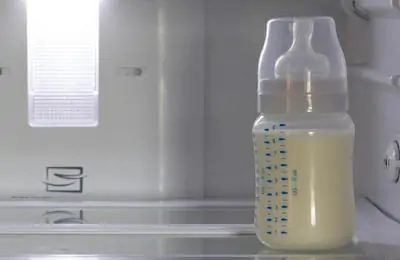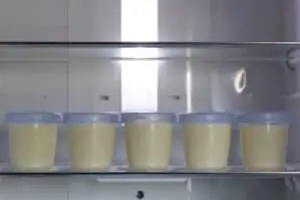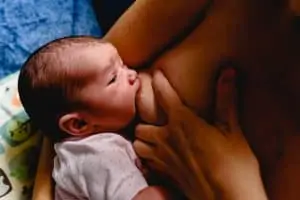My husband and I were just talking about our youngest as a baby the other day. I’d just finished nursing her, and he was laying with her on top of his chest.
The moment was so precious, and I snapped photos. But as soon as I put my camera away, she spits up…right onto his cheek!
It was a blob of curdled milk. And the funniest part? My husband had just told her she smelled like cheese and that he liked cheese too.
Did I panic? Nope.
Because I knew she was fine.
How did you know that, Leslie?
Well, I had plenty of practice with my eldest, of course, who wasn’t much of a spitter-upper. But the younger one surely was.
And generally, when a breastfed baby is spitting up curdled milk, you shouldn’t be concerned. Honestly, a baby spitting up curdled milk and crying or spitting up curdled milk from the nose is also normal.
Let’s get into all the why behind why your baby is spitting up curdled milk!
Why is my baby spitting up curdled milk?
When a baby is spitting up yellow curdled milk, it’s really more alarming for you than for your baby. No baby spits up curdled milk right after eating…it becomes curdled when breastmilk or formula mixes with those stomach acids.

If your baby spits upright after feeding, it will resemble how it went, which is like milk or formula. But as time goes on, your baby could be spitting up curdled milk stuff.
So why is your baby throwing up curdled milk and clear liquid? There are a few reasons. Even a 1 year old throwing up curdled milk may cause you concern, but I can assure you that there’s nothing to worry about most of the time.
Digestive problems
With newborns, in particular, the digestive system is still developing. So depending on your baby, you may have more spit up than another mom sees. And as for formula-fed babies, they may react to the formulas that contain cow’s milk. On the rare side of things, it could be lactose intolerance or an allergy to the milk protein. If that’s the case, you’ll see something like diarrhea along with it. Usually, though, it’s just the digestive system trying to keep up.
You can certainly discuss formula options with your pediatrician regarding digestive woes. And most babies will grow out of these problems, as your doctor will likely tell you.
Reflux
Babies can have acid reflux too. I’ve written about this recently, so please check it out. Please don’t switch to formula from breastmilk or change your formula until you try a few things because it could be these simple changes that will stop the problem.
Some babies will spit up because your flow or the flow of the bottle you use gives them too much at once. Try a new breastfeeding position or hold the baby with the bottle more upright (and switch to a slow-flow bottle if you’re using formula).
You can also avoid certain trigger foods like spicy foods, tomatoes, citrus, high-fat foods, and carbonated beverages.
There are rare things out there, too, like pyloric stenosis, a really rare condition that happens at about 3 to 5 weeks old. It’s so rare, but if your baby projectile vomits, loses weight, and has constipation, those are all signs.
See?
Now you’re worried, and I didn’t want that for you. If you think this rare issue is something your baby has, take her to the doctor, and you’ll find out for sure (but honestly, with it affecting 3 out of 1,000 babies in America, chances are it’s not pyloric stenosis).
What does it mean to throw up curdled milk?
So, when a baby spits up curdled milk, it’s because the breastmilk or formula has mingled with the stomach acid. The pH drops and makes it more acidic, and the longer it’s in the stomach, the more curdled and even yellow it can appear.
Baby spitting up curdled milk: Is it good or bad?
Well, no one likes to spit up, but it is part of #momlife. In all seriousness, it is not an indication of illness. It can happen when you’re burping your baby, and it’s normal.
Spitting up is not the same as vomiting. But Leslie, aren’t they the same?
Nope!
Vomiting is way more forceful and kind of comes up; pardon the pun, with greater force. There’s also way more when a baby vomits. Vomiting up curdled milk and clear liquid may indicate a virus or some sort of illness. Check for fever and call the doctor for that one. Ensure that the baby continues to get breastmilk or formula to prevent dehydration.
Why does my breast milk look curdled?
Your breast milk itself can look curdled if you have it stored in the fridge. It can vary from mom to mom in consistency and color. And in flavor, too though I have not tried it myself. I have noticed that my milk looked differently from other moms and vice versa. It’s kind of neat, actually.

Once you express your breast milk, you do need to take care to keep it fresh. It will never spoil in your breasts. It needs to be put in the fridge and can stay there for 5 days (frozen for 6 months).
As it is homogenized, you’ll notice that it will separate into layers in the fridge. The top layer looks creamy, while the bottom looks watery. It could even look clumpy, but you’ll see it restored to the proper consistency if you swirl it.
If you think it’s gone bad, take a sniff and follow my other tips on determining if your stowed breastmilk is still ok. Generally, your nose should tell you whether it’s still good to go.
Work on reducing spit-up
Curdled-looking or not, if you want to reduce spit-up for your newborn, try my upright position suggestion and check that bottle. If you nurse and have someone else bottle-feed baby with breastmilk while sleeping or at work, make sure you get those slow-flow bottles.
For moms who formula-feed, check those bottles and make sure you’re holding the baby in an upright feeding position.
And for all mamas, make sure you’re not just putting baby right back down after feeding. Hold her upright for 15 to 20 minutes and help her burp first. This will cut down on all types of spit-up.
Leslie Berry lives with her husband and two young daughters in Los Altos, California, where she loves helping other moms get comfortable with motherhood and embracing the insanity with facts peppered with laughs.
She loves eating too much sushi, exercising, and jamming out on her Fender. Read more about Leslie here.






